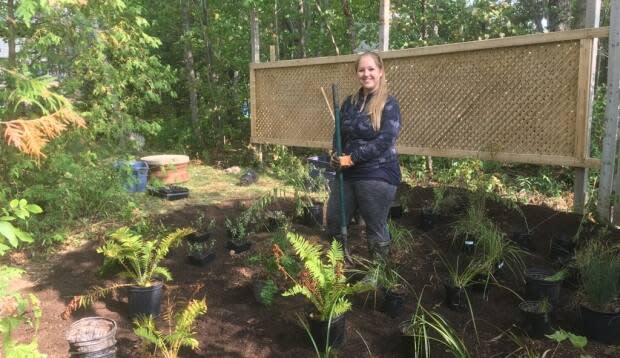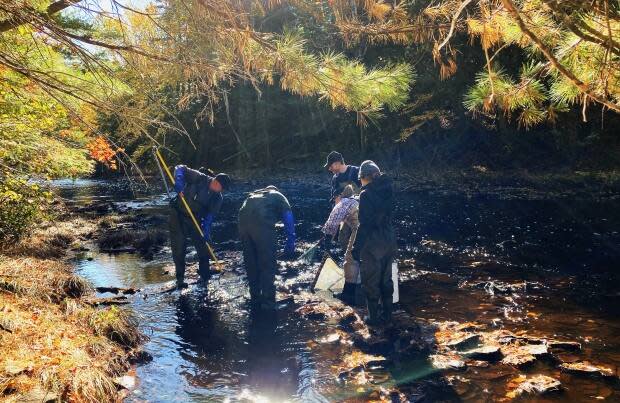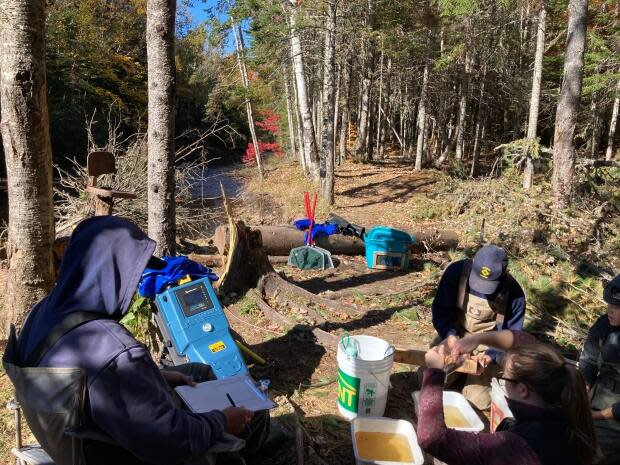Environmental groups shock salmon to study them humanely

Two environmental groups recently teamed up to research the presence of Atlantic salmon in the Shediac Bay watershed — and they used a backpack that pumps electricity into the water to do it without harming the fish.
The Shediac Bay Watershed Association conducted the survey in October with the help of the Friends of the Kouchibouguacis. The survey was funded through a grant from the Atlantic Salmon Conservation Foundation.
The goal of the survey was to collect data that can spur conservation efforts. The survey looked at several species but focused on confirming the presence of Atlantic salmon in the waterways.
"It's about trying to protect that species, trying to identify where that species inhabits our waters, where they spawn," said Jolyne Hébert, manager of the Shediac Bay Watershed Association.

"It's unfortunate that there isn't better protection for all our waterways. But sometimes we need that extra push to say, 'We have a sensitive species existing here, it's important for spawning, it's important for the general population,'" she said.
"And when you help to protect the Atlantic salmon, you often help to protect a whole variety of other species."
The research was conducted using a method called electrofishing, where a technician wears a backpack that looks like it could've been part of someone's Ghostbusters Halloween costume, and temporarily stuns fish so they can be moved into containers for examination.
Hébert said it's a preferred survey method because it helps researchers catch every fish in the area.
"It's using a current of electricity that actually attracts fish to what we call the stun zone," she said. "And just to be clear, this means of sampling does not harm the fish."
WATCH | Wade into the river with electrofishers
A shocking survey method
The association has used electrofishing before, but not since 2018.
Hébert said this was partly because of the equipment's cost, as well as losing staff who were trained and certified to use the tools. The Friends of the Kouchibouguacis had the equipment and the know-how to help the association bring the method back to their operations.
Before beginning the electrofishing, the team ran tests to see what kind of electric output would be appropriate for the water they were working in.
"Once we see that fish get stunned and recover after about 10 seconds, and then they're perfectly fine, we know we're at a good voltage," Hébert said.
That 10 seconds gives researchers enough time to plop the fish into a bin for later examination.

After the four-year electrofishing hiatus, the recent expedition was a success.
"We thought it was time to … do another quick evaluation to see where we're at, if we can still find Atlantic salmon in our watercourses," she said.
"And we were very glad to find them."
Collecting data to spur action
The survey was conducted in the main branch of the Shediac River, the Weisner Brook and the Scoudouc River. In the Scoudouc, the team was excited to find an American eel.
"It's a species of commercial and cultural importance. So it's exciting to be able to find it because we don't have a whole lot of data on their spawning locations [in] our watershed," Hébert said.
But their main search was for salmon. The survey wasn't focused on assessing the current state of their population, which would require repetitive surveys the association doesn't have the capacity for, just the presence of the species.

The survey did provide a measure of the waterways' biodiversity, which Hébert said is good but not excellent.
Now that they've collected data on the existence of Atlantic salmon in the Shediac River watershed, Hébert said it will help them improve the population's future.
"[This data] can really help push for change and push for restoration actions," she said. "It can help us receive funding for these types of restoration projects or help others do the same type of work."

Restoration actions could include planting trees, which play a role in creating the cool water salmon prefer.
"Forestry and agriculture that is too close to our waterways often eliminates the tree canopy coverage that is needed to keep our water temperatures down," she said.
To fix this, the association looks to partner with landowners who are willing to let the association come in to plant trees on their property or help rehabilitate their land.


